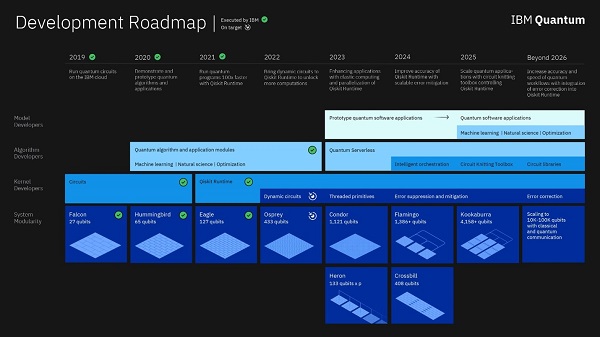credit: IBM
At its Think 2022 conference this week, IBM declared its intent to deliver a 4,000+ qubit processor (“Kookaburra”) built with multiple clusters of scaled quantum computing processors.
The updated quantum plan comes a year after IBM’s last roadmap announcement at Think 2021, in which IBM doubled down on delivering a 1,121-qubit processor by 2023. Now the company has upped the ante promising a nearly 4x-qubit increase by 2025 when it will introduce the Kookaburra 1,386-qubit multi-chip processor. IBM said it will have communications link support for quantum parallelization enabling three Kookaburras to connect into a 4,158-qubit processor.
It’s interesting to note that while IBM has stepped away from the supercomputing systems business, the company has invested heavily in quantum systems building, which has the potential to deliver far more compute power than traditional supercomputers, at least for some workloads.
Jay Gambetta, vice president of IBM Quantum, said in a blog post yesterday that the organization envisions “quantum-centric” supercomputing systems and has developed a “plan to weave quantum processors, CPUs, and GPUs into a compute fabric capable of solving problems beyond the scope of classical (HPC) resources alone.”
Melding quantum and classical HPC under one roof contrasts with the general expectation that quantum will handle specialized workloads, complementing and standing alongside classical supercomputing systems.
“In the last few years, we’ve seen the emergence of AI-centric supercomputers, where CPUs and GPUs work together in giant systems to tackle AI-heavy workloads,” Gambetta stated in his blog. “Now, IBM is ushering in the age of the quantum-centric supercomputer, where quantum resources — QPUs — will be woven together with CPUs and GPUs into a compute fabric. We think that the quantum-centric supercomputer will serve as an essential technology for those solving the toughest problems, those doing the most ground-breaking research, and those developing the most cutting-edge technology.”
 He said IBM is developing “new modular architectures and networking that will allow IBM quantum systems to have larger qubit-counts – up to hundreds of thousands of qubits.” Enabling them will be “an increasingly intelligent software orchestration layer to efficiently distribute workloads and abstract away infrastructure challenges.”
He said IBM is developing “new modular architectures and networking that will allow IBM quantum systems to have larger qubit-counts – up to hundreds of thousands of qubits.” Enabling them will be “an increasingly intelligent software orchestration layer to efficiently distribute workloads and abstract away infrastructure challenges.”
This approach will consist of three pillars, IBM said, scalable quantum hardware, quantum software to orchestrate and enable accessible quantum programs, and an ecosystem of quantum-ready organizations and communities.
A core piece of IBM’s strategy is the Qiskit Runtime platform, its containerized quantum computing service and programming model. Earlier this year, IBM launched Qiskit Runtime primitives designed to encapsulate common quantum hardware queries used in algorithms into interfaces. In 2023, IBM said, it plans to expand these primitives to allow developers to run them on parallelized quantum processors to speed up the user’s application.
IBM originally announced its quantum roadmap in 2020. Since then, the company has delivered on IBM Eagle, a 127-qubit processor with quantum circuits that cannot be reliably simulated exactly on a classical computer, and whose architecture laid the groundwork for processors with increasingly more qubits, according to IBM. Additionally, IBM said it has delivered a 120x speedup in molecule simulation using Qiskit Runtime compared to a prior experiment in 2017. Later this year, IBM said it expects to continue the previously laid out targets on its roadmap and unveil its 433-qubit processor, IBM Osprey.

IBM’s “Kookaburra” quantum processor
IBM said in 2023 it will build a frictionless development experience with Qiskit Runtime and workflows built in the cloud, to bring a serverless approach into the quantum software stack “and give developers advanced simplicity and flexibility. This serverless approach will also mark a critical step in achieving the intelligent and efficient distribution of problems across quantum and classical systems.”
IBM said is targeting three regimes of scalability for its quantum processors.
The first involves building capabilities to classically communicate and parallelize operations across multiple processors, enabling a broader set of techniques for practical quantum systems, such as error mitigation techniques and workload orchestration, by combining classical compute resources with quantum processors that can extend in size.
The next step involves short-range, chip-level couplers that connect multiple chips to form a single and larger processor and allow for modularity that is key to scaling, according to IBM.
The third scalability component are quantum communication links between quantum processors. “To do so, IBM has proposed quantum communication links to connect clusters together into a larger quantum system,” the company said.



